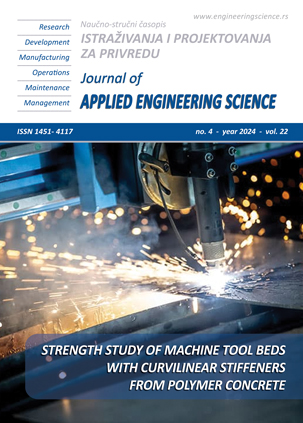PLASTIC BLOCK FOR BUILDING CONSTRUCTION MATERIAL
Abstract
Plastic wrap waste increase from time to time. Efforts are needed to utilize them as they are less demanded for recycling by the private sectors in Bali and Indonesia. This paper describe effort to use combination of waste thin plastic wrap as plastic block for wall construction material. The plastic wrap wastes were cut into 5-10 mm size, then they were melted in a hot waste engine oil at 200°C. The mixture was then poured into a metal mold, slightly cooled down and compressed using a compression machine. The mixtures produced was without and with added rice husk ash as filling material. The size of the plastic block was 20×10×8cm. It was found that the densities of the samples were less than 1gram/cm3, the compressive strength can achieve 25kg/cm2, the Porosities were low, ranges from 0.220-0.290%, the Initial Rate of Suctions (IRS) were very low ranges form 0.0004-0.00075 kg/m2.minute, and the and water absorptions were also low (0.02-0.03) %. In general, the compressive strengths were comparable to low quality bricks commonly produced.
References
Jambeck, J.R., Andrady, A., Geyer, R., Narayan, R., Perryman, M., Siegler, T., Wilcox, C., Lavender Law, K. (2015). Plastic waste inputs from land into the ocean, Science, 347, p. 768-771, https://jambeck.engr.uga.edu/landplasticinput, accessed on 8-4-2024.
Syakriah, A. (2024). Three siblings and their team, Sungai Watch, are fighting against Bali’s pollution problem. The Guardian, 17 January 2024. https://www.theguardian.com/environment/2024/jan/17/stomach-churning-team-wading-through-nappies-to-clean-up-bali-waterways, accessed on 16-4-2024
Rochman, C.M. (2018). Microplastics research-from sink to source. Science, vol. 360, no. 6384, 2018, pp. 28-29. https://rochmanlab.files.wordpress.com/2018/09/rochman-2018-science.pdf, accessed on 12-3-2024.
Sharma, P., & Sharma, K. P. (2012). Utilization of waste plastic in asphaltic concrete. International Journal of Engineering Research and Applications, 2(4), 2289-2293.
Siddique, R., Khatib, J., & Kaur, I. (2013). Utilization of waste plastic bottles in asphalt mixture. Journal of Hazardous, Toxic, and Radioactive Waste, 17(2), 152-157.
Arulrajah, A., Piratheepan, J., & Bo, M. W. (2012). Recycling waste PET bottles as an alternative construction material for sustainable development. Construction and Building Materials, 30, 120-125.
Smith, J., Johnson, R., & Davis, M. (2018). Characterization of Low-Quality Bricks for Sustainable Construction. Journal of Sustainable Materials, 4(2), 87-95. DOI: https://doi.org/10.1080/20462498.2017.1380935
Mason, T. (2017). Analysis of Masonry Block Properties for Low-Cost Housing. Construction Materials Journal, 23(3), 45-52. DOI: https://doi.org/10.1016/j.conbuildmat.2016.11.090
United States Environmental Protection Agency (USEPA). (2018). Managing, Reusing, and Recycling Used Oil. Retrieved from https://www.epa.gov/usedoil, accessed on 10-3-2024
Hutton, A. (2016). Environmental impacts of used oil disposal. European Journal of Sustainable Development Research, 1(1), 1-10.
National Research Council (NRC). (2019). Spills of Nonfloating Oils: Risk and Response. National Academies Press.
Energy Information Administration (EIA). (2020). How much carbon dioxide is produced when different fuels are burned? Retrieved from https://www.eia.gov/tools/faqs/faq.php?id=73&t=11, accessed on 11-2-2024
World Health Organization (WHO). (2016). Ambient air pollution: Health impacts. Retrieved from https://www.who.int/airpollution/ambient/health-impacts/en/, accessed on 10-3-2024
Siddique, R., Khan, M.I., & Nazari, A. (2018). Sustainable construction materials: Rice husk ash. Elsevier.
Gupta, R., Kumar, R., & Kumar, A. (2020). Utilization of rice husk ash in stabilization of expansive soils. Construction and Building Materials, 250, 118898.
Krebs, R.D., and Walker, R.D. (1971). Highway Materials (McGraw-Hill, 1971).
Vekey, R.C.de. (2001). Construction Materials: Their Nature and Behaviour, Third Edition, Spon Press, London and New York, p. 288.
Dinton, I N., Ardika I W. (2024). Lab Test Report on Water absorption of Local Fired Clay Brick in Denpasar, Bali, Indonesia, Civil Eng. Dept. Udayana University (unpublished lab technician report).
Thanaya, I N.A., Purbanto, I G.R., and Putra, D.G.D. (2023). Characteristics of Plastic Block Wall Materials (PBWM) Using Waste Engine Oil, Crackle Plastic, Mineral Water Plastic Cups Cover and Label of Plastic Bottle Without and With Rice Husk Ash and Natural Aggregates Filling Materials, E3S Web of Conferences, Volume 445 (2023), 14 November 2023. Available at: https://www.e3s-conferences.org/articles/e3sconf/abs/2023/82/contents/contents.html
British Standard Institution (BSI). (1975). Methods for Sampling and Testing of Mineral Aggregates, Sands and Fillers: Physical Properties.
Indonesian National Standard (INS). (1989). Quality and Testing Method of Solid Concrete Block, SNI 03-0348-1989.
Indonesian National Standard (INS). (2001). SNI-06-6721-2002. Method of Testing the Viscosity of Asphalt Emulsion Using Saybolt.
Sasui, Hengrasmee, S.J.W. (2017). Variation in Compressive Strength of Handmade Adobe Brick. International Journal of Scientific and Research Publication, http://www.ijsrp.org/research-paper-0917/ijsrp-p6906.pdf, accessed on 12/09/2021.
Al-Ajmi, F., Abdalla, H., Abdelghaffar, M., dan Almatawah, J. (2016). Strength behavior of mud brick in building construction. Civil Engineering Open Accessed Journal, http://dx.doi.org/10.4236/ojce.2016.63041, acessed on 12/09/2021.
The Constructor. (2023). Standard Specification for Hollow and Solid Concrete Blocks. https://theconstructor.org/concrete/hollow-solid-concrete-blocks specification/54785/#Compressive%20Strength%20and%20Density, accessed on 25-7-2023.
Awoyera, P.O., Oladimeji, B., Olalusi, Ibia, S., Prakash, A.K. (2021). Water absorption, strength and microscale properties of interlocking concrete blocks made with plastic fiber and ceramic aggregates. Case Studies in Construction Materials, Elsevier, Vol 15 Dec 2021. https://www.sciencedirect.com/science/article/pii/S2214509521001923, accessed on 25 July 2023.
Kore, S.D. (2019a). Sustainable Utilization of Plastic Waste in Concrete Mixes - a Review, https://zenodo.org/records/2538208 , visited 8-9-24
Raghatate Atul, M. (2012). Use of plastic in a concrete to improve its properties. International journal of advanced engineering research and studies, 1(3), 109-111.
Kore, S.D. (2019b). Feasibility Study on Use of Plastic Waste as Fine Aggregate in Concrete Mixes. Journal of Building Materials Science. https://journals.bilpubgroup.com/index.php/jbms/article/view/1204, visited 8-9-24.
Intara, I W. (2015). Characteristics of Local Bali Red Brick. Matrix Journal, Vol. 5, NO. 1, March 2015. http://download.garuda.kemdikbud.go.id/article.php?article=739440&val=11654&title=KARAKTERISTIK%20BATA%20MERAH%20LOKAL%20BALI , visited on 14-10-24

